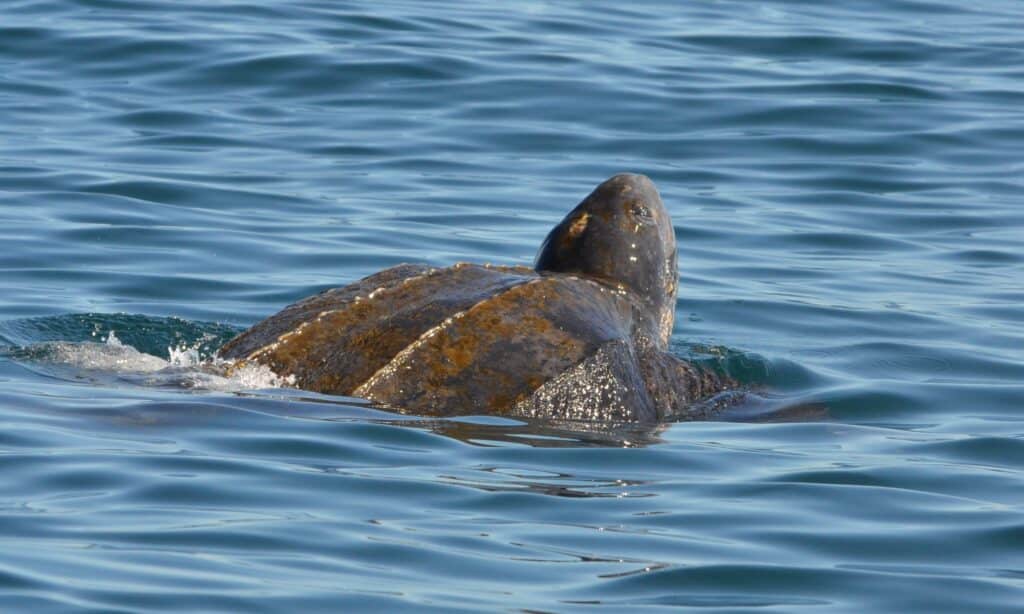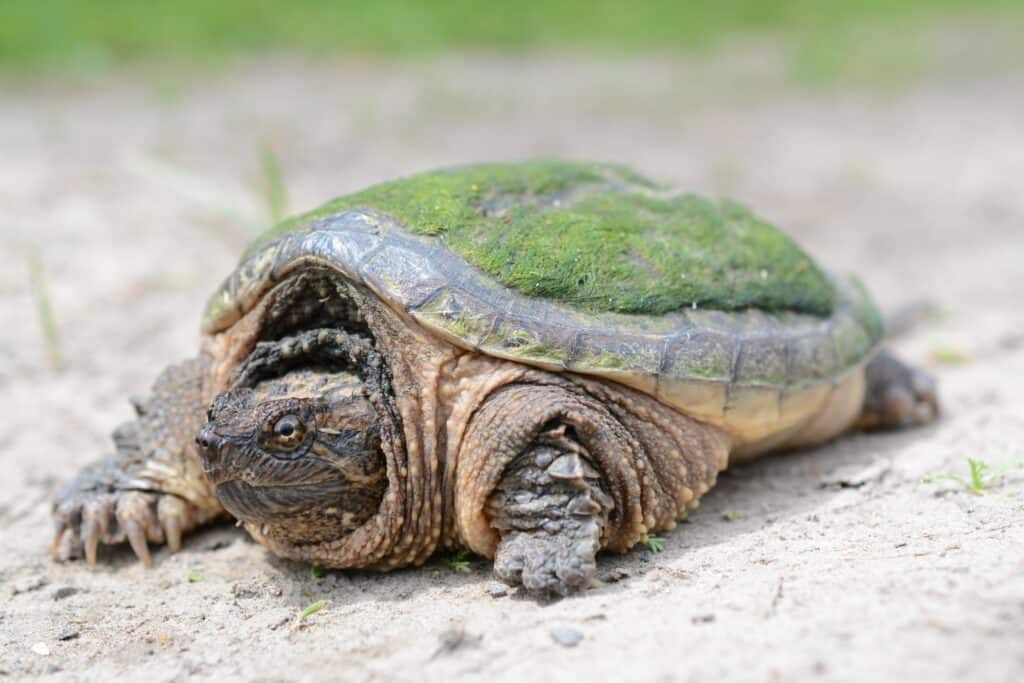Although turtles are quite resilient animals, they must rely on their surroundings to keep their bodies warm. As ectothermic reptiles, they cannot self-regulate their internal body temperature like mammals can, so it’s worth asking: where do turtles go in the winter? If they live somewhere with chilly winters, do they keep warm by migrating, hibernating, or perhaps something else entirely?
Let’s break down how all different kinds of turtles–from terrestrial tortoises to aquatic sea turtles–get through the cold winter months. We’ll cover where migrating turtles go to stay warm and how they cover such great distances, of course, but we’ll also touch on the unique species that simply prefer to stay in place and weather the storm.
How Do Turtles Survive the Winter?

Most turtles brumate by burrowing in soft mud, sand, and leaf litter, or submerging fully under the frozen surface of a pond or lake.
©iStock.com/Wildpix645
As mentioned above, turtles are ectothermic reptiles. Their body temperature relies on the temperature of their surroundings. Typically, reptiles like turtles will move to a warmer location, like atop a rock or a log, and bask in the sun to raise their body temperature. Similarly, if they’re too hot, they’ll move to a cooler spot, like a pile of cool mud or a log under a shady tree.
But what about when winter rolls around and temperatures drop drastically? Can turtles survive these temperatures? Do they migrate somewhere warmer? It depends on the type of turtle!
Generally speaking, non-marine and terrestrial turtles stay in place to brumate in the winter. This process is similar to hibernation. Essentially, they go into a deep sleep state where they use very little energy and their metabolism slows significantly.
Most non-marine turtles can withstand temperatures as low as 35oF or so–just above freezing. By staying very still and relying on stored energy, they can tolerate these cold temperatures for months at a time!
Most turtles brumate by locating a safe spot where they can burrow in soft mud, sand, and leaf litter, or submerge fully under the frozen surface of a pond or lake. Some freshwater and terrestrial species do migrate seasonally to find slightly more ideal conditions to survive the winter, though these are usually short distances of a mile or two at most.
Sea turtles, however, can migrate much longer distances seasonally from cooler to warmer waters in the winter and vice versa in the summer. This is because they are much larger and much stronger swimmers than freshwater and terrestrial turtles. Their strong flippers and tear-drop-shaped bodies can cut through rough ocean currents with ease. They can swim hundreds or thousands of miles in just one season!
How Do Brumating Turtles Survive Underwater?

Aquatic turtles that brumate underwater during the colder months are able to draw oxygen from the water through cloacal respiration.
©iStock.com/jtstewartphoto
Although turtles that brumate in the winter use very little energy, they still have to breathe and absorb oxygen (and, in turn, get rid of carbon dioxide) to survive. This is fine for many terrestrial turtles that only partially burrow themselves into dirt, mud, and leaf litter. But what about the species that opts to brumate fully underwater in near-freezing temperatures for months at a time?
Nope, they don’t simply hold their breath all winter! Amazingly, aquatic turtles that brumate underwater during the colder months are able to draw oxygen from the water via a process called cloacal respiration (also known as enteral respiration).
To put it simply, a turtle’s cloaca is a body cavity that serves multiple purposes. Mainly, it expels waste and houses the turtle’s genitals for reproduction. While most mammals like us humans have separate orifices for these purposes, the majority of reptiles, amphibians, and birds simply have a cloaca.
Amazingly, in addition to getting rid of waste and taking care of reproduction, many turtles can use their cloacae to exchange respiratory gases, primarily oxygen and carbon dioxide. This way, they don’t have to come to the surface to breathe and can basically breathe through their butts!
Some turtles, like sea turtles, utilize cloacal respiration to extend their dives when searching for prey. Meanwhile, freshwater turtles use it to brumate underwater. This way, they can sit safely under the frozen surface of a pond for months at a time, staying hidden from hungry predators.
Where Do Migrating Turtles Go in the Winter?

Turtles will simply look for a safe, quiet spot where they can hide and brumate for up to 4 months at a time.
©Trevor Meunier/Shutterstock.com
Now that we have a better idea of how brumating turtles get through the winter, what about the turtle species that migrate?
As we touched on earlier, most freshwater and terrestrial turtle species don’t wander far from their homes, even in the winter. Most stick to a home range of a few acres to a few miles at most. Surprisingly, they’re skilled navigators, looking to the position of the sun to navigate or even sensing magnetic fields to get to and from the location they plan to overwinter.
Usually, these turtles will simply look for a safe, quiet spot where they can hide and brumate for up to 4 months at a time. Again, this spot can be a pile of mud, leaf litter, an expansive burrow, or even fully submerged under the frozen surface of a pond or lake.
But the turtles that migrate the farthest are definitely sea turtles. They mainly travel to and from their nesting and foraging sites, but they also migrate seasonally in response to changing temperatures.
All seven living species of sea turtles can swim thousands of miles in a single year! Most of them can withstand temperatures as cold as 50oF or so. Any colder than this, and they risk becoming “cold-stunned” and washing ashore and dying.
When sea turtles begin to sense temperatures dropping, they simply start migrating south to warmer waters. They also prefer breeding and nesting in warmer, subtropical, or tropical regions, usually in the months of May through September. Of all sea turtle species, leatherbacks travel the farthest, often swimming 10,000 miles or more per year.
Like the aforementioned freshwater and terrestrial turtles, sea turtles also use complex methods to navigate, like sensing changes in light, temperature, the position of the sun, and the Earth’s magnetic fields.
Up Next:
The photo featured at the top of this post is © Jay Ondreicka/Shutterstock.com
Thank you for reading! Have some feedback for us? Contact the AZ Animals editorial team.






